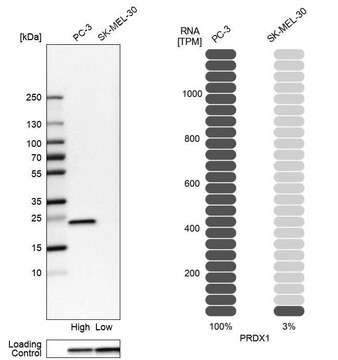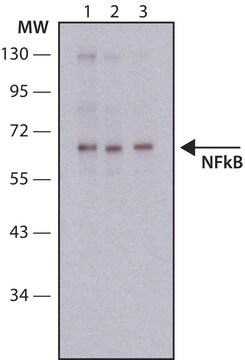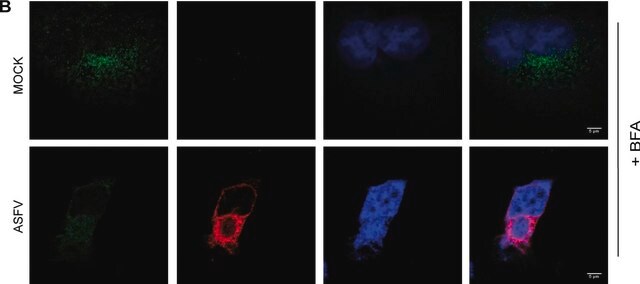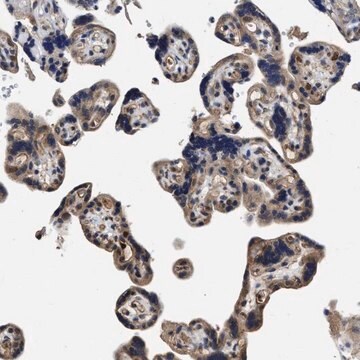推荐产品
生物源
rabbit
共軛
unconjugated
抗體表格
affinity isolated antibody
抗體產品種類
primary antibodies
無性繁殖
polyclonal
形狀
buffered aqueous solution
分子量
antigen 39 kDa
物種活性
human
技術
immunohistochemistry (formalin-fixed, paraffin-embedded sections): 1:200 using formalin-fixed, paraffin-embedded sections of human colon carcinoma
microarray: suitable
western blot: 1:200 using HeLa nuclear extract
UniProt登錄號
運輸包裝
dry ice
儲存溫度
−20°C
目標翻譯後修改
unmodified
基因資訊
human ... JUN(3725)
一般說明
Activation Protein transcription factor 1 (AP-1) is a leucine zipper transcription factor that recognizes a specific palindromic sequence present in several promoters and enhancers. AP-1 can be induced by several growth and apoptosis-related signaling pathways. Jun proteins are also involved in metastatic, inflammatory and stress responses.
Anti-AP-1/c-Jun recognizes an epitope located on the c-Jun DNA binding domain. This epitope is highly conserved in c-Jun, Jun B and Jun D proteins of chicken, mouse, rat, and human. By immunoblotting, the antibody reacts specifically with AP-1/c-Jun (a single band or occasionally a doublet at 39kDa region). Additional bands of lower molecular weight may be observed. Staining of AP-1/c-Jun band(s) is inhibited by the AP-1/c-Jun immunizing peptide (amino acid residues 246-263).
Anti-AP-1/c-Jun recognizes an epitope located on the c-Jun DNA binding domain. This epitope is highly conserved in c-Jun, Jun B and Jun D proteins of chicken, mouse, rat, and human. By immunoblotting, the antibody reacts specifically with AP-1/c-Jun (a single band or occasionally a doublet at 39kDa region). Additional bands of lower molecular weight may be observed. Staining of AP-1/c-Jun band(s) is inhibited by the AP-1/c-Jun immunizing peptide (amino acid residues 246-263).
Activation Protein transcription factor 1 (AP-1) is a regulatory leucine zipper transcription factor. AP-1 is composed of either a homodimer of two Jun protein molecules or a heterodimer of one Jun and one Fos (Proto-oncogenes) molecules.
免疫原
synthetic peptide corresponding to amino acids 246-263 of human c-Jun with N-terminally added lysine, conjugated to KLH.
應用
Anti-AP-1 antibody has been used in
- immunohistochemistry
- immunochemistry
- western blotting
Immunofluorescence of Hela cells was performed using monoclonal anti-AP1 (clone 100/3) as the primary antibody.
生化/生理作用
Activation Protein transcription factor 1 (AP-1) recognizes a specific sequence (TPA response element, a palindromic TRE sequence TGA(C/G) TCA or related sequences) present in many promoter and enhancer gene regions. Regulation of AP-1 is achieved by changes in the expression of Jun and Fos proteins in the dimer, by phosphorylation at both Ser63 and Ser73 by c-Jun N-terminal kinases (JNK) and by interaction with a variety of transcriptional coactivators like C-Jun activation domain-binding protein-1 (JAB1). AP-1 is induced by a variety of signals including those eliciting proliferation, differentiation and apoptosis.
外觀
Solution in 0.01 M phosphate buffered saline, pH 7.4, containing 1% bovine serum albumin and 15 mM sodium azide.
免責聲明
Unless otherwise stated in our catalog or other company documentation accompanying the product(s), our products are intended for research use only and are not to be used for any other purpose, which includes but is not limited to, unauthorized commercial uses, in vitro diagnostic uses, ex vivo or in vivo therapeutic uses or any type of consumption or application to humans or animals.
Not finding the right product?
Try our 产品选型工具.
儲存類別代碼
10 - Combustible liquids
水污染物質分類(WGK)
WGK 3
閃點(°F)
Not applicable
閃點(°C)
Not applicable
P Angel et al.
Nature, 332(6160), 166-171 (1988-03-10)
Proto-oncogenes encode proteins with three main sites of action: the cell-surface membrane, the cytoplasm and the nucleus. Although the exact biochemical function of most proto-oncogene products is not understood, several of them are known to be involved in signal transduction.
Samuel Jang et al.
Cancer medicine, 6(9), 2142-2152 (2017-08-05)
Notch signaling is minimally active in neuroendocrine (NE) cancer cells. While histone deacetylase inhibitors (HDACi) suppress NE cancer growth by inducing Notch, the molecular mechanism underlying this interplay has not yet been defined. NE cancer cell lines BON, H727, and
Jiping Da et al.
Critical care medicine, 35(1), 26-32 (2006-11-11)
Nitric oxide inhibits the expression of many genes involved in inflammatory diseases. Glucocorticoids inhibit similar transcription factors. We hypothesized that there may be an interaction between nitric oxide and glucocorticoids, with the potential to enhance the anti-inflammatory effect when administered
AP-1 function and regulation
Karin M, et al.
Current Opinion in Cell Biology, 9(2), 240-246 (1997)
Twelve hours of heat stress induces inflammatory signaling in porcine skeletal muscle
Ganesan S, et al.
The American Journal of Physiology, 310(11), R1288-R1296 (2016)
我们的科学家团队拥有各种研究领域经验,包括生命科学、材料科学、化学合成、色谱、分析及许多其他领域.
联系技术服务部门








